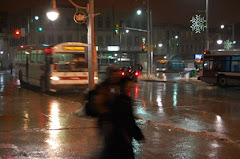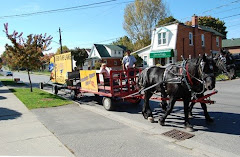Throughout the entire budget process we've heard council ask questions, and staff suggesting that these questions might be better answered, or resolved, on the budget message board. So let's take a look at what's been talked about on the message board as we look forward to Tuesday's passage of the Tax-Supported Operating Budget.
Local Boards and Shared Services
1) Councillor Salisbury asked, what are the constraints if the $100,000 increase for the Guelph Neighbourhood Support Coalition is tied to a commensurate decrease to the Guelph Police Services budget?
Chief Jeff DeRuyter said: While he's on the board of the GNSC, and he sees first-hand the good that they do in the communities represented, the additional funding does not relieve an pressure on the Police budget as they're not just looking at present need, but future needs. DeRuyter added that Sgt Hasham's comments at the public delegation night a few weeks ago, when he said that if he had the choice he would give $100,000 to GNSC while taking $100,000 from the Police budget, was his own personal opinion, and that the Sargent has "minimal to no role" in the annual development of the Police budget.
2) Mayor Guthrie asked, if council chose not to approve $70,000 budget increase for the hiring of a library security guard, would they just not do it?
Staff said: The hiring of a security guard is seen as an "essential element" to the delivery of library services in 2018, so without the extra $70,000, they would have to cut services to pay for it, and they further note that there's no expansion of the library operating budget into other areas. "The Board’s goal is to provide a safe environment for both library staff and library users," staff added.
Tax-supported Operating Budget
Expansions
1) A request was made to post the original memo for the request for security guards in city facilities.
2) Councillor Salisbury asked if the $40,000 funding for the Diversity and Inclusion expansion could be included in part, or in whole, in the base budget?
Staff said that the reason this funding was asked for in the expansion is because each department was limited to a 0.5 per cent increase in spending, so without the expansion there would be no funding to move forward with such a program. The goal of the Diversity and Inclusion plan is to promote equal employment and help assure that the City is compliant with revised Human Rights Legislation.
3) Councillor Salisbury asked that considering many of the Corporate Service expansions involves knowledge or activities presently being overseen by staff, can these things be covered in the base budget?
Staff said, again, that this is a matter of spending increases in each department being limited to 0.5 per cent. The expansions, though optional, represent a need on the part of the City to mitigate risk, and make sure that the organization has proper work force planning.
4) Councillor Salisbury asked about the impact of hiring a new WSIB Claims and Disability Co-ordinator, and whether strategic wellness initiatives can be done by the current Disability Claims Occupational Health Specialist?
Staff said it's about the workload. The new co-ordinator will focus on effective wellness initiatives, be able to analyse health trend data, monitor City drug use, and benchmark health data available through a number of organizations, as well as develop programs to proactively address employee health concerns. As well, the new co-ordinator can ensure continuity of service delivery during times when the Disability Claims Occupational Health Specialist is out of office.
5) Mayor Guthrie asked if a reserve fund could be created for enhancements to transit service conditional on completion of the service review? Specifically, the $480,000 council *didn't* approve for chamber upgrades.
Staff said that no service changes should be undertaken with transit until the service review is completed so that the process can be as effective as possible. Having said that, council can decide to transfer funds as it sees fit. The $480,000 currently sites in the Infrastructure Renewal Reserve Fund, but it's worth noting that this was one-time funding.
6) Councillor Allt asked (for a resident), does the increase in staff over the last few years, as a percentage, at the same pace of the population growth of Guelph?
Staff said, excluding staff for the Public Health and the Elliott, the number of Full-Time Equivalent (FTE) positions at the City of Guelph has grown seven per cent since 2011, while Guelph's population has increased eight per cent. So it's pretty close.
Infrastructure, Development and Enterprise Services – Operating
1) Someone on staff asked, what's the difference in costs between city waste collection for multi-residential units, and private collection?
Staff said that based on the information they received from owners with private garbage collection they're costs are between $150-$200 per unit while the Solid Waste Service Review indicated that City of Guelph waste collection cost closer to $80 per unit.
2) Someone on staff asked, how does the costs of multi-residential waste collection in Guelph compare to Barrie?
Staff said that there are three main reasons for the difference in cost: a) Barrie owns and operates its own landfill, b) Barrie requires its multi-residential developments to pay for their bins versus Guelph who doesn't want to create a difference between property owners, and c) Guelph has more multi-residential properties than Barrie.
3) Someone on staff asked, what are the risks in not expanding multi-residential waste collection?
Staff said that the 2014 Solid Waste Management Master Plan recommended that the City build an adequate collections system for multi-residential buildings, as densificiation would mean about 30 per cent of Guelph's population would live in multi-residential developments in the next 15 years, and without them, the waste diversion rates will be negatively affected. There would also be a growing appearance of inequality when it comes to waste collection, which could have an effect on growth as people may decide against moving to the city without City waste collection at their preferred housing choice if that's a townhouse or condo.
4) Someone on staff asked, what ware the additional costs of collected more multi-residential waste?
Staff said about $80,000 for additional public education and communications. There are no additional administrative costs to expanding waste collection.
5) Someone on staff asked, what impact will collecting multi-residential waste have on diversion rates?
Staff said that while the collection of more recyclables and organic material is a good thing, there's no way to know exactly how the diversion rate will be affected in advanced given that it will depend on contamination levels and the make-up of the material.
6) Someone on staff asked, what percentage of multi-residential customers don't receive municipal waste collection services?
Staff said that the City collects from two-thirds of all multi-residential properties in Guelph including 44 per cent of all apartment buildings and 88 per cent of all townhouses. Right now, there are about 182 properties representing over 9,300 units that are likely candidates for expansion, but the City has an eye to transfer all properties to City collection sometime in the next three to five years.
7) Someone on staff asked, what are the costs of various frequencies of yard waste, and what savings are there-in?
Staff posted this graph, which shows the various costs and the savings incurred as frequency increases. The bi-weekly approach will also reduce yard waste associated traffic by as much as 80 per cent, so there are benefits in other area stoo.
8) Someone on staff asked about the cost related to the service review of Solid Waste.
Staff said, apparently, there is a negative variance due to added investigation into additional reporting in Health and Safety and Engineering for the review. That expense will be offset by positive variances from areas that under-spent.
9) Someone on staff asked, how will staff communicate any increases in tipping fees or yard waste changes once the budget is approved?
Multiple ways including handouts to be distributed at PDO; Mobile signs; Media releases; City News ad in the Mercury Tribune; Guelph.ca webpage updates to all relevant existing webpages (e.g. PDO fees); Social media messages; and memos to customers with accounts.
Public Services – Operating
1) Councillor MacKinnon asked, what would the impact on the transit budget be if cash fares were raise from $3 to $4, while the price of passes and tickets remained the same?
Staff said that Transit would add about $168,668 in revenue, but at the same time it would lose about 17 per cent of its ridership; there's a thing called fare elasticity, which means that for every one per cent increase in fares, you lose 0.5 per cent of your ridership. At the same time, the City would end up losing $291,156.11 in revenue from gas taxes since it's calculation is based on total population (30 per cent) and transit ridership (70 per cent). So basically, Guelph would lose nearly all of what it made by increasing the fares in the first place.
2) Councillor Downer asked staff to explain the "eight platoon chiefs in training" described by Pat Fung on public delegation night.
Staff said that the reference was to the fact that eight captains in the fire service are paid an additional four per cent per year to basically be on call to cover the platoon chief if he's ill, or on vacation, or absent for some other reason. This also helps with succession planning having multiple candidates who can step into the role if its time for someone to get a promotion, so this is just sane planning, and not just some accounting trick.
3) Someone on staff asked for more information about federal and provincial gas tax funding.
Staff said that gas tax revenue is split into two categories: the federal portion is the Federal Gas Tax Fund, which is administered by the Association of Municipalities of Ontario (AMO) who gave Guelph $7,399,405 in 2016. The provincial share is the Dedicated Gas Tax Program, which is administered by the Ministry of Transportation, and gave $2,786,267 in funding to Guelph in 2016.
4) Councillor Downer asked about the latest update of the Urban Forest Master Plan. It's supposed to be posted every five years, so is it being posted in 2018?
Staff said the implementation of the UFMP began as of November 2013, so the update will be due back at the end of 2018 or in early 2019.
5) Someone on staff asked for a brief history of the Guelph Neighbourhood Support Coalition and the City's role in creating it.
6) Councillor MacKinnon asked for the most recent numbers on the sale of the Affordable Bus Pass.
From staff, average sales per month in 2016 were 1,283, while 2017 (through October 31) has seen an uptick of 1,391. The year end total for 2016 was 15,401, while the number sold as of October 31 this year was 13,905. So the year will likely end with an increase in sales of the affordable pass.
7) Councillors Allt and Wettstein both asked, why wasn't an increase in the Guelph Neighbourhood Support Coalition budget included initially by staff?
Again, the limited 0.5 per cent increase provided a short ceiling for Culture, Tourism and Community Investment. In fact, many organizations who have Community Benefit Agreements asked for an increase beyond the cost of living increase, but despite the individual merits of each case, it just wasn't possible. The GNSC was then told they were free to make their case to council directly, which they did on public delegation night.
8) Someone on staff asked for more information about the subsidy review.
Staff reviewed the current income eligibility of the Low Income Cut-off (LICO) and compared it to the Low Income Measure (LIM). Now LIM would cut off benefits at a slightly higher lever than LICO, which would mean an additional cost to the City of $109,000. That's a difference of between 1.7 per cent between the number of people covered under LICO and LIM, which translates to about 2,100 Guelph residents. There will be changes to the applying for subsidies in 2018 including a single application for all subsidy programs, improved privacy, improved accessibility, and more user friendliness.
9) Someone on staff asked, what caused the increase in benefits to Fire Services?
From staff, sick leave, statutory holiday pay, WSIB presumptive legislation and a new line of duty benefit all contributed to the increase of that line item.
10) Councillor Salisbury asked, what would the effects be if the City used existing staff to implement the Affordable Housing Financial Incentive Program?
Staff said that a new staff contact on the program will build and strengthen partnerships with local organizations and stakeholders. Presently, staff doesn't have the resources to pursue this, so if this duty is to be taken on by a current staff member, then other programs would have to be ceased or cancelled altogether.
11) Someone on staff asked, what's the deal with the increase in purchased good for Fire Services?
Staff said it's new tech. Complex new technologies that have to be integrated with the existing equipment, which is not cheap.
12) Someone on staff asked for Guelph Museums attendance numbers.
The most recent numbers come from 2016. Between the Civic Museum and McCrae House, 29,241 visits were received with 17,330 general admissions, 8,424 special events, and 3,487 school visitors. The museums are expecting higher numbers for 2017 thanks to Canada 150 and Guelph 190.
General – Operating
1) Mayor Guthrie asked if it's possible to slash spending on catering, travel expenses and advertising by about $50,000 each.
Staff said that cutting that much from travel, which is $60,491 higher in 2018, would mean that the City would have to reconsider participating in some intergovernmental meetings, and/or mandatory/legislated training requirements. The budget for this item is nearly $312,000 for 2018. The corporate communications advertising budget meanwhile is $166,000, which is spent on print and web advertising, both the buying of production, and the buying of media placement. On top of that, the advertising is meant to drive revenue to the City. As for catering, the City is already spending over $8,000 less on this line item in 2018, and a $50,000 cut would eliminate over 75 per cent of that budget. In other words, no more sandwiches at Committee-of-the-Whole (probably).
2) Councillor Downer asked, when will council learn more about heritage incentives?
The Cultural Heritage Action Plan, which was initiated in the fall of 2017, is scheduled to be completed in the fourth quarter of 2018, which likely means it will come back to council at the beginning of 2019.
3) Councillor Gibson asked about the $289,000 positive variance from the third quarter of 2017 because of "logistical delays in filling vacancies." He wanted to know what positions are unfilled, how long they've been vacant, and the impact to public service?
Staff said that a "gapping strategy" is taken into account in the budget-building process. Also, "Adjusting certain existing vacancies would have an effect on the service
and program delivery and results in a broader issue of a Council
directed motion that is aligned with service reviews." Gibson asked for further clarity, but has yet to receive it.
4) Councillor Gibson asked for details on the changes to the purchased goods and services budget.
5) Mayor Guthrie asked about using the projected year-end surplus and re-investing it as this year's contribution to the infrastructure levy in lieu of the additional one per cent.
Staff said, in brief, that the surplus is currently just a forecast, and it's presently unknown what exactly the year end numbers will be.
6) Councillor Hofland asked, what's the estimate revenue from development charges in 2018?
Staff said $21 million.
7) Mayor Guthrie asked if staff had thought about reaching an efficiency target for 2018 like, say $500,000?
Staff noted again that save for compensation and utilities, they were given a cap of 0.5 per cent for departmental increases, which represents only $1.1 million in total increases to the 2018 budget. To cut another $500,000 on top of that, it could result in lower goods and services spending, which is unrealistic unless council wants it to affect service delivery. Furthermore, staff are recommending a County Social Services budget at $695,883 lower than the County's own submission, and thanks to gapping, staff is looking to save another $1.8 million. Finally, staff suggests that if council would like to cut further, then they should bring forward a specific recommendation.
8) Councillor Downer asked for examples of efficiencies and reduced expenses in the budget.
Staff points to energy efficiencies in hydro that are bringing down costs, the elimination of the vacancy rebate, a reduction in insurance claims, and a reduction of the purchased goods and services budget.
9) Someone on staff asked where they can find the number of FTEs and part-time employees are unionized?
Staff said that in 2017, of the 1,576.26 FTEs, including police and library workers, 78 per cent are unionized. Most casual part-time positions (less than 20 hours per week) are not unionized.
10) Someone on staff asked why a 10-year funding strategy is so important? Why not just budget the levy year-to-year depending on affordability?
Stability mostly. And presently, staff is working on a fully-funded 10-year forecast for the 2019 budget.
11) Someone on staff asked about the impact of a two per cent levy over five years versus a one per cent levy over 10 years?
There isn't much of a difference in terms of dealing with the infrastructure backlog.
12) Someone on staff asked, how much does the one per cent Dedicated Infrastructure Levy make taxes go up over 10 years?
Staff said that using 2016 as the base year, the increase is 14 per cent over 10 years. If a property pays $3,500 in property taxes in 2016, the total impact could by $490 by the end of the decade.
13) Someone on staff asked, what's the total capital transfer as a percentage of the operating budget after 10 years?
Staff said the City currently contributes 13.49 per cent, but if the City stays the course with the infrastructure levy, the total transfer increases to 23 per cent.
14) Someone on staff asked, how the sustainable funding target was established, and will the target change?
Staff said, the target is based on a funding level estimate based on the 100 year average replacement cost of all assets currently in place. Work on the Corporate Asset Management Division will likely change the figures as completeness, accuracy and reliability of the information on the city's assets becomes more available.
15) Someone on staff asked, what happens to the infrastructure levy at the end of 10 years?
Staff said, "The increase in the annual capital transfer that has been achieved by
the Dedicated Infrastructure Levy will continue to form a portion of the
base tax funded operating budget after year ten (2026)." The main purpose of the 10-year levy though is to close the ever increasing gap, which will be achieved in 2032 if the City stays the present course.
16) Councillor Hofland asked, has there been an increase to special event parking?
Staff said no change has been recommended. The present $5.00 flat fee ($4.43 plus tax) for Special Event Parking at the East and West Parkades and Baker Street Lotwill remain.
17) Someone on staff asked if there's a way to show the amount for the infrastructure levy differently on the tax bill?
Due to the software used and the existing provincial legislation on the matter, options are limited, but a more detailed answer on this question will be coming to Committee-of-the-Whole in February.
18) Councillor Hofland asked for the one page 2018 tax-supported operating budget summary.
19) Councillor Gordon asked how Community Energy and Climate Change are mentioned in the budget?
Staff referred to the section on Facilities Management (5-8, or page 42 of the PDF file) to answer Gordon's question. Under "2018 Initiatives", it mentions, "Continued leadership and involvement with Community Energy Initiative
task force now known as Our Energy Guelph in the development of our
community energy plan." This section also mentions, "Developing a spirit of collaboration through the creation of the Energy, Water, and Climate Change committee," which will focus on energy efficient projects. Intergovernmental Affairs and Finance will help the EWaCC committee find external funding for specific projects they pursue.


















No comments:
Post a Comment